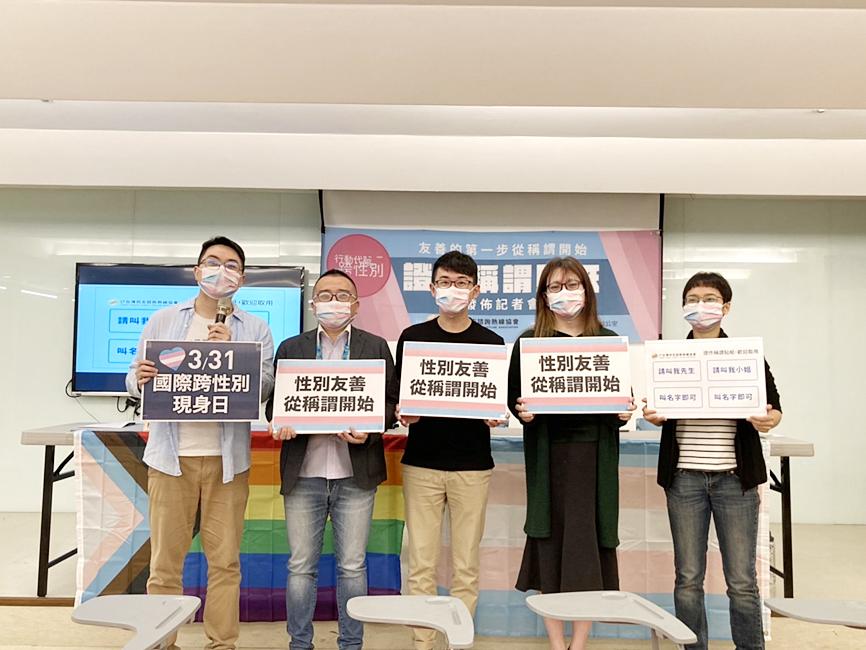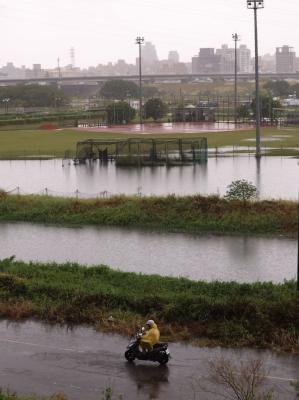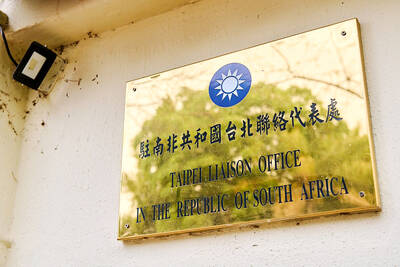The Taipei and Kaohsiung city governments now allow residents to attach a sticker to their ID cards that specifies their gender identity, an LGBTQ+ association said on Thursday, which was International Transgender Day of Visibility.
The decision, which gives transgender people an opportunity to formalize their identity, was made by the two city governments in collaboration with the Taiwan Tongzhi Hotline Association, one of its members told a news conference.
The stickers can be obtained at household registration offices, city hospitals and other major medical facilities in Taipei, and at district offices in Kaohsiung, said Olivia Tsai (蔡瑩芝), an executive member of the association.

Photo: CNA
The stickers, which can be attached to any form of national ID card, indicate whether the bearer wants to be identified as “mister,” “miss” or only by their name, association secretary-general Sean Du (杜思誠) said.
The initiative was announced on International Transgender Day of Visibility to educate the public about the daily struggles of transgender people and to pay tribute to their courage, Du said.
A transgender individual at the event named Alice said that transgender people endure pain and pressure on a daily basis, particularly when they are referred to by the wrong pronoun.
The stickers are meant to correct that, Alice said, adding that the public should start asking people how they would like to be addressed to avoid offending the transgender community.

Taipei, New Taipei City, Keelung and Taoyuan would issue a decision at 8pm on whether to cancel work and school tomorrow due to forecasted heavy rain, Keelung Mayor Hsieh Kuo-liang (謝國樑) said today. Hsieh told reporters that absent some pressing reason, the four northern cities would announce the decision jointly at 8pm. Keelung is expected to receive between 300mm and 490mm of rain in the period from 2pm today through 2pm tomorrow, Central Weather Administration data showed. Keelung City Government regulations stipulate that school and work can be canceled if rain totals in mountainous or low-elevation areas are forecast to exceed 350mm in

EVA Airways president Sun Chia-ming (孫嘉明) and other senior executives yesterday bowed in apology over the death of a flight attendant, saying the company has begun improving its health-reporting, review and work coordination mechanisms. “We promise to handle this matter with the utmost responsibility to ensure safer and healthier working conditions for all EVA Air employees,” Sun said. The flight attendant, a woman surnamed Sun (孫), died on Friday last week of undisclosed causes shortly after returning from a work assignment in Milan, Italy, the airline said. Chinese-language media reported that the woman fell ill working on a Taipei-to-Milan flight on Sept. 22

COUNTERMEASURE: Taiwan was to implement controls for 47 tech products bound for South Africa after the latter downgraded and renamed Taipei’s ‘de facto’ offices The Ministry of Foreign Affairs is still reviewing a new agreement proposed by the South African government last month to regulate the status of reciprocal representative offices, Minister of Foreign Affairs Lin Chia-lung (林佳龍) said yesterday. Asked about the latest developments in a year-long controversy over Taiwan’s de facto representative office in South Africa, Lin during a legislative session said that the ministry was consulting with legal experts on the proposed new agreement. While the new proposal offers Taiwan greater flexibility, the ministry does not find it acceptable, Lin said without elaborating. The ministry is still open to resuming retaliatory measures against South

1.4nm WAFERS: While TSMC is gearing up to expand its overseas production, it would also continue to invest in Taiwan, company chairman and CEO C.C. Wei said Taiwan Semiconductor Manufacturing Co (TSMC) has applied for permission to construct a new plant in the Central Taiwan Science Park (中部科學園區), which it would use for the production of new high-speed wafers, the National Science and Technology Council said yesterday. The council, which supervises three major science parks in Taiwan, confirmed that the Central Taiwan Science Park Bureau had received an application on Friday from TSMC, the world’s largest contract chipmaker, to commence work on the new A14 fab. A14 technology, a 1.4 nanometer (nm) process, is designed to drive artificial intelligence transformation by enabling faster computing and greater power